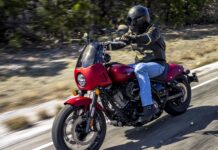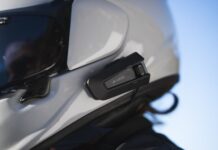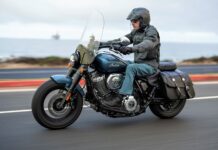BikeMaster
DLFP-30L-BS $319.95
Bikemaster.com
Electronic advancements during the last 20 years have propelled motorcycles into an era of techno gadgetry unimagined by our fathers. With more innovative farkels being unveiled on a weekly basis, power requirements constantly tax both charging and storage systems. Toss in extra cubic inches and high-compression engines and you have a recipe for potential failure when you hit that button on an empty highway and are greeted with an exhausted battery instead of a throaty roar.
My 100th Anniversary Road King came equipped with an AGM battery (Absorbent Glass Mat). Many riders report great success with this unit, accruing a staggering number of miles and years of service. It has seen duty from 1997 to present on all H-D Touring models, demonstrating itself as a reliable product. But a few years ago I wrote a review on a lithium battery, became hooked on the concept and eventually switched all my bikes over to lithium. That first lithium was a tiny thing, in both weight and dimensions. With a weight of approximately six pounds, it was a dramatic change from the OEM AGM that tipped the scales at a massive 22 pounds. And even though it packed a substantial increase in cold cranking amps (CCA) over the stock battery, it was smaller which meant having to cram a sizable amount of packing foam around it to keep it from bouncing around inside the battery carrier. So when I discovered that BikeMaster’s Lithium Ion was exactly the same size dimensionally as the original AGM battery, I made the decision to try something new. Plus there was a 16-percent increase in CCA over my previous lithium unit (from 540 to 625), which meant cold starts on winter days would not be a problem. (Harley-Davidson does not publish ratings for their battery but my research indicates less than 400 CCA).

Installation is a simple procedure, streamlined even further since foam spacers are not required. For improved heat dissipation BikeMaster does recommend elevating the unit above the floor of the battery box using several self-adhesive foam pads supplied with the battery. The OEM top mount Z-bracket used to secure the stock battery was a perfect fit. The positive and negative lugs come with both top and front connections that allow for various cable routing options. A nifty feature not seen before is a push button located on top of the battery that activates an adjacent digital voltage display. More than a novelty, this readout provides for accurate voltage readings on the fly (you can even monitor your charging system by depressing the push button and watching the voltage rise and fall as you operate the throttle).
Additional features include cylindrical cell with energy storage welding technology for higher output, a built-in charge and equalizing protection board that prevents overcharging, an overall weight of 6.2 pounds, vibration-resistant construction allowing for multi-direction installation and a two-year warranty. If ever needed, a conventional lead-acid 12-volt charger (without pulse charging function) or a specially-designed LiFeP04 battery charger can be used for charging. And since it contains no corrosive liquids or toxic heavy metals, it is environmentally friendly. BikeMaster was established in 1983 and is distributed exclusively in North America by Tucker Rocky.
Two days after installation, I left for New Orleans for a 900-mile round-trip weekend. High temperatures and plenty of rain along the ride made no difference in the unit’s quality performance. I feel confident that BikeMaster’s Lithium Ion Battery will provide years of maintenance-free, reliable service.

















